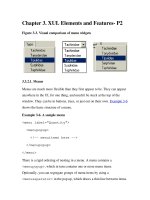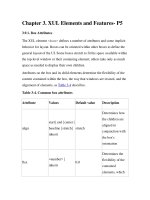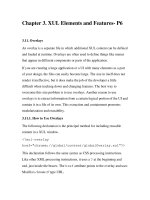Chapter 3 Transmission Basics and Networking Media pdf
Bạn đang xem bản rút gọn của tài liệu. Xem và tải ngay bản đầy đủ của tài liệu tại đây (524.36 KB, 51 trang )
Chapter 3
Transmission Basics
and Networking Media
2
Transmission Basics
•
In data networking, transmit means to issue signals
to the network medium
•
Transmission refers to either the process of
transmitting or the progress of signals after they
have been transmitted
3
Analog and Digital Signals
•
Information transmitted via analog or digital signals
–
Signal strength proportional to voltage
•
In analog signals, voltage varies continuously and
appears as a wavy line when graphed over time
–
Wave’s amplitude is a measure of its strength
–
Frequency: number of times wave’s amplitude
cycles from starting point, through highest amplitude
and lowest amplitude, back to starting point over a
fixed period of time
•
Measured in Hz
4
Analog and Digital Signals (continued)
•
Wavelength: distance between corresponding
points on a wave’s cycle
•
Phase: progress of a wave over time in relationship
to a fixed point
•
Analog transmission susceptible to transmission
flaws such as noise
•
Digital signals composed of pulses of precise,
positive voltages and zero voltages
–
Positive voltage represents 1
–
Zero voltage represents 0
5
Analog and Digital Signals (continued)
•
Binary system: uses 1s and 0s to represent
information
–
Easy to convert between binary and decimal
•
Bit: a single binary signal
•
Byte: 8 bits
–
Typically represents one piece of information
•
Overhead: describes non-data information that
must accompany data for a signal to be properly
routed and interpreted
6
Data Modulation
Figure 3-5: A carrier wave modified through frequency
modulation
7
Transmission Direction:
Simplex, Half-Duplex, and Duplex
•
Simplex transmission: signals may travel in only
one direction
•
Half-duplex transmission: signals may travel in both
directions over a medium
–
Only one direction at a time
•
Full-duplex or duplex: signals free to travel in both
directions over a medium simultaneously
–
Used on data networks
–
Channel: distinct communication path between
nodes
•
May be separated logically or physically
8
Transmission Direction: Multiplexing
•
Multiplexing: transmission form allowing multiple
signals to travel simultaneously over one medium
–
Channel logically separated into subchannels
–
Time Division Multiplexing (TDM)
–
Frequency Division Multiplexing (FDM)
•
Multiplexer (mux): combines multiple signals
–
Sending end of channel
•
Demultiplexer (demux): separates combined
signals and regenerates them in original form
–
Receiving end of channel
9
Relationships Between Nodes
Figure 3-10: Point-to-point versus broadcast transmission
10
Throughput and Bandwidth
•
Throughput: measure of amount of data transmitted
during given time period
•
Bandwidth: difference between highest and lowest
frequencies that a medium can transmit
11
Baseband and Broadband
•
Baseband: digital signals sent through direct
current (DC) pulses applied to a wire
–
Requires exclusive use of wire’s capacity
–
Baseband systems can transmit one signal at a time
–
Ethernet
•
Broadband: signals mo dulated as radiofrequency
(RF) analog waves that use different frequency
ranges
–
Does not encode information as digital pulses
12
Transmission Flaws: Noise
•
electromagnetic interference (EMI): waves
emanating from electrical devices or cables
•
radiofrequency interference (RFI): electromagnetic
interference caused by radiowaves
•
Crosstalk: signal traveling on a wire or cable
infringes on signal traveling over adjacent wire or
cable
•
Certain amount of signal noise is unavoidable
•
All forms of noise measured in decibels (dB)
13
Attenuation
Figure 3-13: A digital signal distorted by noise and then
repeated
Figure 3-12: An analog signal distorted by noise and then
amplified
14
Latency
•
Delay between transmission and receipt of a signal
–
Many possible causes:
•
Cable length
•
Intervening connectivity device (e.g., modems and
routers)
•
Round trip time (RTT): Time for packets to go from
sender to receiver and back
•
Cabling rated for maximum number of connected
network segments
•
Transmission methods assigned maximum
segment lengths
15
Common Media Characteristics:
Throughput
•
Probably most significant factor in choosing
transmission method
•
Limited by signaling and multiplexing techniques
used in given transmission method
•
Transmission methods using fiber-optic cables
achieve faster throughput than those using copper
or wireless connections
•
Noise and devices connected to transmission
medium can limit throughput
16
Cost
•
Many variables can influence final cost of
implementing specific type of media:
–
Cost of installation
–
Cost of new infrastructure versus reusing existing
infrastructure
–
Cost of maintenance and support
–
Cost of a lower transmission rate affecting
productivity
–
Cost of obsolescence
17
Size and Scalability
•
Three specifications determine size and scalability
of networking media:
–
Maximum nodes per segment
•
Depends on attenuation and latency
–
Maximum segment length
•
Depends on attenuation, latency, and segment type
•
Populated segment contains end nodes
–
Maximum network length
•
Sum of network’s segment lengths
18
Connectors and Media Converters
•
Connectors: pieces of hardware connecting wire to
network device
–
Every networking medium requires specific kind of
connector
•
Media converter: hardware enabling networks or
segments running on different media to
interconnect and exchange signals
–
Type of transceiver
•
Device that transmits and receives signals
19
Noise Immunity
•
Some types of media are more susceptible to noise
than others
–
Fiber-optic cable least susceptible
•
Install cabling away from powerful electromagnetic
forces
–
May need to use metal conduit to contain and
protect cabling
•
Possible to use antinoise algorithms
20
Coaxial Cable
•
High resistance to noise; expensive
•
Impedance: resistance that contributes to
controlling signal (expressed in ohms)
•
Thickwire Ethernet (Thicknet): original Ethernet
medium
–
10BASE-5 Ethernet
•
Thin Ethernet (Thinnet): more flexible and easier to
handle and install than Thicknet
–
10BASE-2 Ethernet
21
Twisted-Pair Cable
•
Color-coded pairs of insulated copper wires twisted
together
•
Twist ratio: twists per meter or foot
–
Higher twist ratio reduces crosstalk and increases
attenuation
•
TIA/EIA 568 standard divides twisted-pair wiring
into several categories
–
Level 1 or CAT 3, 4, 5, 5e, 6, 6e, 7
•
Most common form of cabling found on LANs today
22
STP (Shielded Twisted-Pair)
Figure 3-18: STP cable
23
UTP (Unshielded Twisted-Pair)
•
Less expensive, less resistant to noise than STP
•
Categories:
–
CAT 3 (Category 3): up to 10 Mbps of data
–
CAT 4 (Category 4): 16 Mbps throughput
–
CAT 5 (Category 5): up to 1000 Mbps throughput
–
CAT 5e (Enhanced Category 5): higher twist ratio
–
CAT 6 (Category 6): six times the throughput of CAT 5
–
CAT 6e (Enhanced Category 6): reduced attenuation
and crosstalk
–
CAT 7 (Category 7): signal rates up to 1 GHz
24
Comparing STP and UTP
•
Throughput: STP and UTP can both transmit data
at 10, 100, and 1000 Mbps
–
Depending on grade of cabling and transmission
method used
•
Cost: STP usually more expensive than UTP
•
Connector: Both use RJ-45 and RJ-11
•
Noise Immunity: STP more noise-resistant
•
Size and scalability: Max segment length for both is
100 m on 10BASE-T and 100BASE-T networks
–
Maximum of 1024 nodes
25
10BASE-T
•
Fault tolerance: capacity for component or system
to continue functioning despite damage or partial
malfunction
•
5-4-3 rule of networking: between two
communicating nodes, network cannot contain
more than five network segments connected by
four repeating devices, and no more than three of
the segments may be populated









